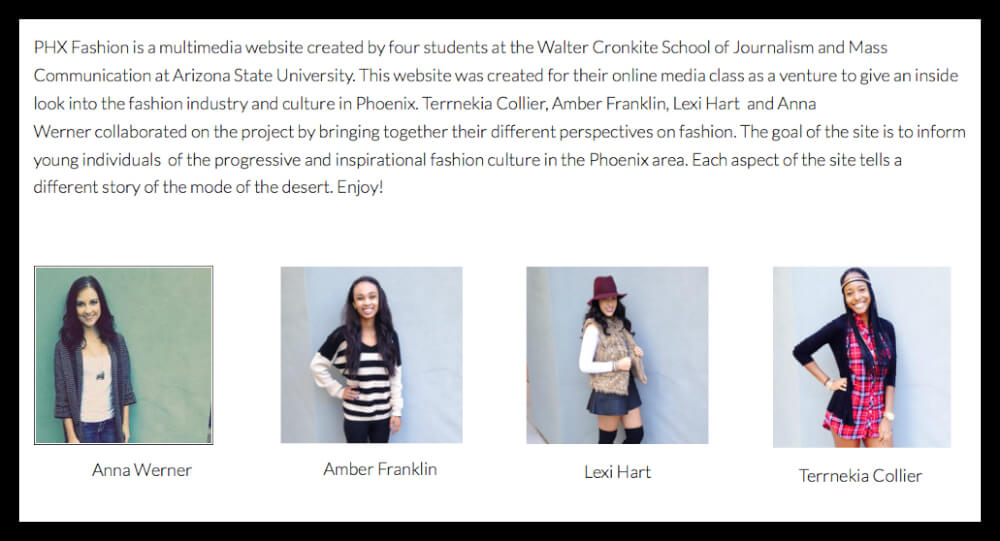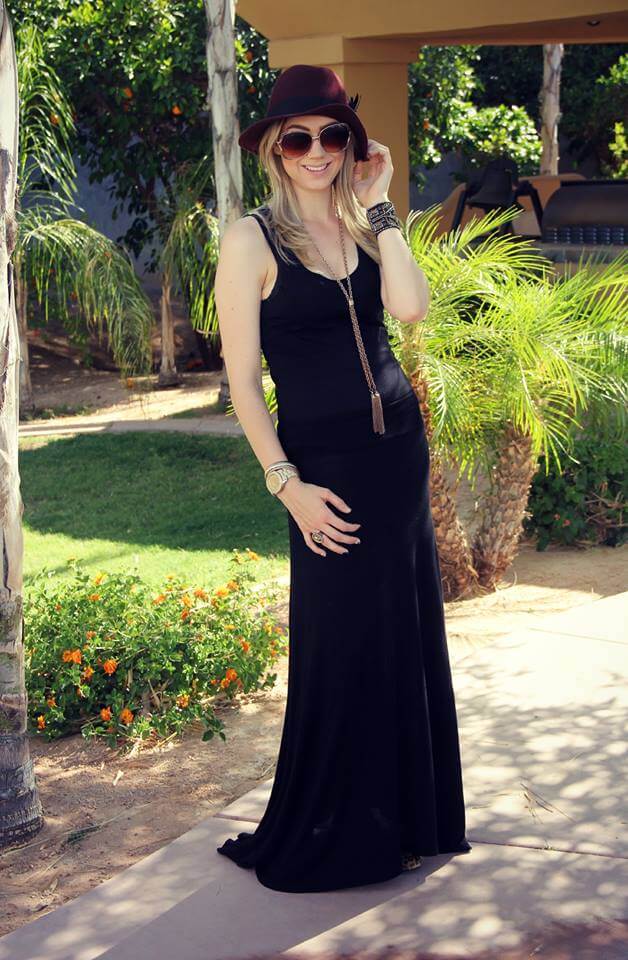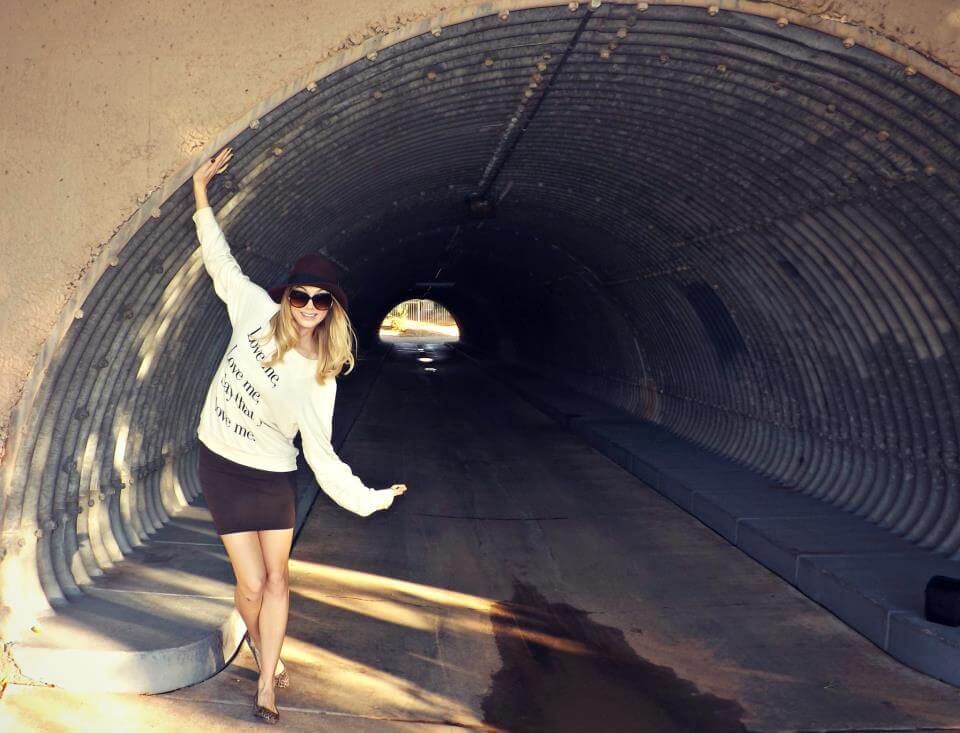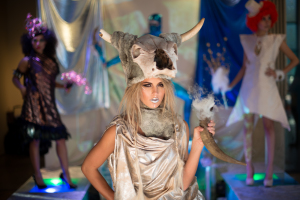This questions was posed to ASU journalism student, Lexi Hart. She and her classmates were desperate to prove to their professor at the Walter Cronkite school of Journalism that fashion is a legitimate topic that deserves to be discussed both as entertainment and as local news.
Lexi, who has also modeled for Phoenix Fashion Week in past years, contacted me asking if she could do an interview about my view of the Arizona fashion scene. Of course I was more than happy to oblige.
Check out my honest and true opinion of the fashion scene here in the desert.
“I DON’T LIKE MEDIOCRE.
I DON’T DO MEDIOCRE.”
Lexi: Talk about Couture in the Suburbs, how did it get started?
Lindsay: I founded it with one other girl… we decided it wasn’t a good fit working together anymore so her and I split ways and I am still running the blog and I have a team of girls that write underneath me.
Lexi: What makes Couture in the Suburbs unique?
Lindsay: I’d say the localization of everything [Couture in the Suburbs only covers things that pertain to Arizona], and also the fact that our team is still very young. The oldest people on it are 22. We bring a really young perspective to it, and that’s kind of fun because a lot of the bigger players in town like Scottsdale Magazine and Arizona Foothills are run by older individuals so it’s just a different perspective.
Lexi: How has the blog grown over the last year?
Lindsay: After my first year with the blog, we were really trying to figure out who we were. We really focused on events and writing about what happened so people who weren’t there could experience it for themselves. I said, ‘The New York Times has their story up the very next morning, so that’s what we’re going to do.” When we started getting attention for that, that’s where we really started to see success.
Lexi: Do you have any local bloggers whose work you read regularly?
Lindsay: I love the Business of Fashion website, it’s one of my favorite websites because they write about what’s going on in the industry – and that’s what I want to do is write about what’s going on in the Arizona industry. I look more towards larger influencers and bring it to a local level, rather than looking at what else is going on around me.
Lexi: Speaking of the ASU Business of Fashion club, you started it, correct?
Lindsay: Yes, I started that with Audree of Simply Audree Kate, and Chloe Bosemy.
Lexi Why did you start it?
Lindsay: When I got involved in the fashion scene I was amazed at how many different positions there were. It’s not just being a fashion designer, a model, and a stylist. There’s so much more than that. So, I wanted other people to learn about what that was like and have opportunities.
Business of Fashion at ASU is really focused on providing internship opportunities to students as well as approaching everything with an educational background. Every week there are multiple internship opportunities, and it has been so amazing to connect students with the local fashion industry and educate them about the larger fashion industry as well… It’s really important for students to get that hands-on experience, and it also helps you figure out if you like a certain position or if you don’t.
Lexi: How did you begin the process of presenting students with internship opportunities?
Lindsay: Through Couture in the Suburbs, I had met a lot of people in the local fashion industry and they were all asking me if I wanted to intern for them, but there was only one of me. All of my friends were asking me, “How do you get these opportunities?” I saw the club as a way to bring them together and really create a community of people with those who are already involved mentoring people who want to be involved. Since then, people still reach out to me about getting interns and I pass them on to Business of Fashion.
Lexi: Let’s talk about you for a bit. Why do you love fashion?
Lindsay: It kind of goes back to me being empowered as a woman. Women are judged on the way they look; I don’t think it’s right, I don’t think that’s how I should be, but that’s how it is. Fashion allows you to express who you are in one place. Fashion and beauty allow women to present themselves how they want and to get that respect or create that persona for themselves.
Lexi: Which designer influences your own personal style the most?
Lindsay: I get inspiration from a lot of different things. I really love Yves St. Laurent; he was really cool because he knew what women wanted to look like before women know what women wanted to look like. I absolutely adore him.
Honestly, I look for pieces that speak to what I like. I like things that are unique but easy to wear, I hate being fussy and uncomfortable.
And anything black.
Lexi: What is your favorite fashion piece in your closet?
Lindsay: That’s so hard! But… I love my shoes. One of my favorite looks is a black oversized dress that I pair with these tall boots and it elevates the style immediately. I’m 5’8” but I love to be taller… I’m 6’4” in some of the shoes that I wear, so when you walk into a room and you’re that tall, people pay attention.
Lexi: What’s your go-to outfit?
Lindsay: It depends on what it’s for. For events, always a little black dress, black shoes, and a red lip. You will never look bad, you will never look out of place. You could walk into an interview, you could walk into a party or you could walk into work and you will always look good.
Lexi: Phoenix Fashion Week is a pretty big event in the Phoenix fashion scene. Do you think this event contributes to fashion being a large part of Arizona?
Lindsay: I think that Phoenix Fashion Week (PHXFW) is a huge voice. It’s a great way for people to come together because there are so many different events throughout the year. There are meet-ups, the Emerging Designer Announcement, the Model Announcement, Shop Garment District, Phoenix Fashion Week and Spring Into Fashion.
Going to the meet-ups is so easy – I think that’s why PHXFW contributes so much to the fashion scene here – because they make it very accessible for anyone and everyone to get involved.
Lexi: What do you thing PHXFW could do better?
Lindsay: I think that they need to focus more on the caliber of designers they bring in, and celebrate the designers who are doing a really great job. I think that there is street wear, and then there’s fashion. Street wear is not fashion; t-shirts, bathing suits… that stuff is great and I love those brands, but it’s not fashion.
To me, if you’re going to call yourself “Phoenix Fashion Week” and you’re going to talk about raising the fashion scene in Phoenix, it needs to start with the caliber of fashion that’s shown on the runway. They know how to put on an event, they know how to get people excited, now I want them to really nurture designers and select designers with potential to create real fashion.
I think that there were some instances this past Phoenix Fashion Week where a designer was okay, that could have been great. The business side of fashion is very important, but the business side doesn’t matter if you have a crappy product. It just doesn’t.
So they’re doing a great job with the business side of things, but to get a designer to go from a local boutique into Barney’s, which is where designers like Hues of Ego and Kismit have the potential to be, they need to learn more about design, fabric, etc and stop focusing on a boutique price point and instead focus on doing really good fashion. That’s what’s going to raise the Arizona fashion scene.
To raise the Arizona fashion scene, we need people outside of Arizona to pay attention.

Kismit at Shop Garment District – Photo Courtesy of Almanza Photography
Lexi: You wrote a very honest article constructively critiquing the designers after their fashion lines debuted on the runway for the first time. What was the response from that? (See the article here)
Lindsay: Some of the designers actually thanked me. I even got a text from Brian Hill [the Director of Phoenix Fashion Week] the next day and he told me that he went over that article with the designers in their seminar. I had a lot of anxiety writing that article – I was writing about my friends. That’s hard to do… it’s hard to publically criticize someone you care about. So having Brian text me that was really cool.
It was actually a defining moment for me because I had decided that I really wanted Couture in the Suburbs to focus on the best of fashion, because like I said earlier, that’s what going to raise the fashion scene. I stopped caring if someone was upset with me if that’s what they needed to hear.
Lexi: How do you see Phoenix’s fashion scene evolving over the next few years?
Lindsay: I think it’s going to be very influenced by art because there’s a really strong art scene here. It won’t be the beachy, laidback style that’s LA, it’s not going to be uptight like New York. It’s going to be really interesting, but easy because – well, it’s hot.
Lexi: Changing gears, let’s talk about your career with blogging. What advice do you have for others wanting a career in fashion?
Lindsay: Start local. An internship in New York is great, I would never discount it, but those internships are literally making copies and getting coffee. You get to work on one cool project – like organizing the shoes for a photoshoot. That’s honestly what internships in New York are like.
With my internships here in Arizona, I got to actually work on projects that mattered. I wrote press releases for an art gallery that went out to all the news stations, I was calling places all over the country getting them to pick up a designers line… I actually got to do hands-on things. Start locally to get the skills and then look for big companies to hire you.
Lexi: Final question: Where do you see Couture in the Suburbs in five years?
Lindsay: My ultimate goal for it would be it looking like Woman’s Wear Daily but with emerging fashion. Phoenix is the “suburb” of the fashion industry, and that’s where I came up with the name, so if I really went with this, I’d love to have a Couture in the Suburbs: Phoenix, a Couture in the Suburbs: Dallas, a Couture in the Suburbs: wherever. I want to write about people who are getting their start, because that’s what’s interesting to me: writing about them as they start and then seeing where they end up.
So how did the project turn out?
“I truly think we convinced her (the professor) that Phoenix is absolutely a market for fashion. I don’t think that would have been possible or that our argument would have had the same affect if it weren’t for your interview.
To see more of their project, visit PhxFashion.weebly.com



















